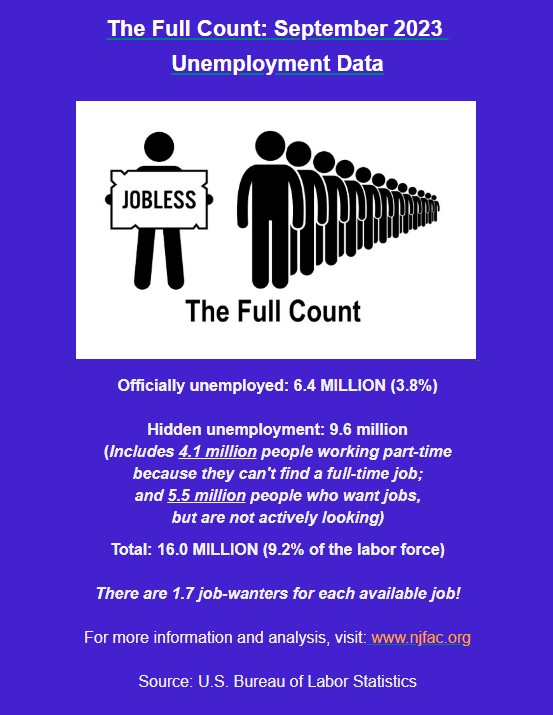
by Frank Stricker
October 11, 2023
In the latest Bureau of Labor Statistics’ jobs report, The Employment Situation—September 2023, the official unemployment rate stayed at 3.8%. The National Jobs for All Network’s comprehensive rate, including more job-needers and part-timers who want full-time work, was also stable but at a very high level of 9.2%. An exception to the Bureau of Labor Statistics’ generally positive report was the unemployment rate for black teens, which jumped from 16.9% to 24%, an increase of 42%!
In the The Employment Situation, the biggest news came from the payroll job counts that the BLS gets from employers. The total number of non-farm employees in the U.S. increased by 336,000 people. That is much more than analysts predicted, and it is more than 267,000, the average for the prior twelve months. This is good news that may be bad news to Federal Reserve officials who want slower job and wage growth to restrain prices. And there’s more bad good news. The number of employees in food services and drinking places rose by 61,000, and those sectors are back to where they were in February of 2020. Finally, to add worry to Fed Chair Jerome Powell’s brow, there are the adjustments to monthly job totals that the BLS normally makes as employers continue to send their numbers to the Bureau. Often the final numbers are revised downward, but this time, job totals for July and August increased by 79,000 and 40,000.
Talk about grief. The Fed wants slower job growth and less economic demand overall in order to rein in inflation. In fact, inflation has been falling for months. Consumer prices are now rising about 4% a year. Something is working, and it may not be the Fed’s lifting interest rates sky high. That policy has not slowed the economy much or at all, as it was supposed to do. An alternative explanation is that other factors lifted the supply of many goods as producers here and abroad rebounded from supply-side obstructions, and also as tons of federal money poured into the economy to create demand that stimulated supply. In any case, we have not had a recession or a major economic slowdown, and yet price increases are falling.
To reiterate a general point, in the employer reports, the news for workers is good. Substantially more jobs. Also, from another source, we learn that initial claims for unemployment insurance for the last three weeks of September were among the lowest weeks of the whole year. Finally, in August, the latest month of available data from BLS JOLTS reports, we see that the number of job openings turned up a little. Good for workers if it is a trend and not a glitch.
Are We Headed for a Recession?
To paraphrase Paul Krugman, economists have a perfect record when it comes to forecasting recessions. They are never right. In fact, inflation rates are falling toward the Fed’s goal of 2% a year. There is no reason to push the economy into a recession. Higher interest rates may not even be the tool that is restraining prices. And prices on many items—not all–are rising more slowly. Annual inflation rates for January 2021-January 2023 were 6.43%. The increase for the twelve months ending in August of 2023 was 3.7%.
Of course, we must keep an eye on prices, but it is time for mainstream economists and commentators to focus on wages. Yes, some workers are on strike or have won their strikes. But millions of workers get really lousy pay and benefits, have no strong organization to join, and cannot afford to protest by taking many days or even weeks off of work. We need federal good-jobs programs, and we need to lift wages. National politicians ought to be ashamed that they have not raised that abomination, the $7.25 federal minimum wage. And also that invitation to employer wage-theft called the “tipped wage.” It actually allows employers in some states to include tips as part of the guaranteed $7.25 hourly wage.
[1] Mike Konczal, “Supply-Side Expansion Has Driven the Decline in Inflation,” September 8, 2023, The Roosevelt Institute.
[2] Paul Krugman and Peter Coy, “Is a Recession Imminent?” The New York Times, SR, 8, October 1, 2023.
Frank Stricker belongs to Democratic Socialists of America and is on the board of the National Jobs for All Network. He is a retiree-member of the California Faculty Association, the union for professors in the California State University and College System. He wrote American Unemployment: Past, Present, and Future. His opinions are not necessarily those of any of his organizations.

